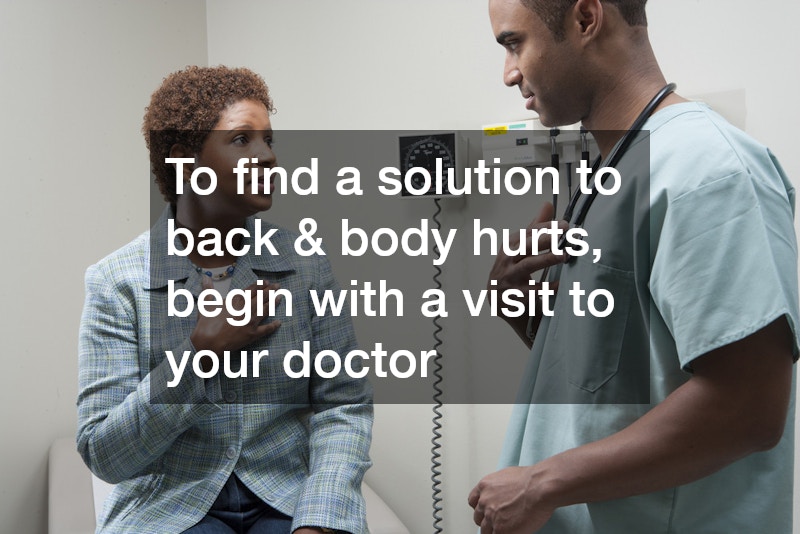What to Do About Chronic Back Pain

If you struggle with chronic back pain, it can feel overwhelming. Many people with back pain find themselves unable to work, and some find it difficult to perform daily activities like bathing and grooming. There are many types of back pain treatment. Your treatment will depend on the origin and the cause of your back pain.
For example, if you experience sharp lower back pain when bending over, it may be due to a herniated disc or spondylolisthesis. Both those conditions involve a displacement of the vertebrae or spinal disc and can often be relieved with a chiropractic adjustment. If you experience back pain when bending sideways, it can also be a disc problem, but it may also be due to an injured muscle or ligament.
To find a solution to back & body hurts, begin with a visit to your doctor. If any activity leaves you with lingering pain, stop that activity until you see your doctor. By consulting your healthcare provider when your back pain is minor, you may be able to prevent it from becoming chronic. When playing sports, always use any protective equipment recommended by your coach or team leader.

The human skeleton is engineered for a lifetime of walking upright, and this is the result of millions of years of evolution. Our early primate ancestors started running and hunting for game, as opposed to living in trees, and this led to an upright, bipedal form. Today, the human skeleton features an S-shaped spine, an upright pelvis, long leg bones, and arched feet. This gives the human race many advantages, though it does come at a cost. Walking upright like that can wear out the spine as it fights gravity, and today, millions of Americans are contending with chronic back pain or back pain symptoms. But only the most serious cases of back injury call for surgery; meanwhile, non invasive medicine such as the use of chiropractic adjusting tools and range of motion testing solutions at a hospital can be used. These rehab tools and systems don’t require any incisions or medicine, but they can certainly get the job done. When is it time for range of motion testing solutions or other physical therapy tools like that?
Rates of Chronic Back Pain
First, let us consider how often and why Americans are experiencing back pain and spinal distress. Many surveys and studies are done to track modern public health, and that includes back pain. The numbers show that at any given time, around 31 million people are experiencing chronic back pain, and 50% of working Americans get back pain symptoms every single year. Such pain may affect one in three women and one in four men at any time, and experts say that 80% of the population or so will experience back pain at some point in their lives.
What is causing all of this back pain? For one thing, many surveyed Americans blame ongoing stress for their back issues, and pregnant woman may experience back pain as well. Meanwhile, working hard manual labor jobs for years, such as construction, is known to put wear and tear on the spine and back muscles, leading to high chances of back pain later in life. Suffering a sports injury or a car accident can also distress the back or spine. Finally, simple old age can also cause back pain, when the spine collapses on itself from a lifetime of fighting gravity and bends forward. This may pinch nerves and strain muscles, as well as inflame the joints and reduce mobility, causing a great deal of pain overall.
Hospital Solutions For Back Pain
A hospital patient who needs physical therapy can get all kinds of help, such as with the aid of range of motion testing solutions, stretch tests, and algometers, among others. Physical therapists can use these range of motion testing solutions on the patients with care, such as capturing the patient’s movements on camera and studying the data with specialized programs to measure the patient’s progress. The patient may also perform any exercises or stretches necessary, to restore their mobility and muscle strength and coordination. Handheld devices such as digital pressure algometers can be used on any localized part of the body, to put pressure on the muscles and test the resistance. This can provide accurate data on the patient’s muscle strength and pain thresholds, very useful references for recovery.
Going to a Doctor
Someone who is suffering back pain doesn’t have to end up at the hospital to recover, though. Often, Americans with back pain visit their doctor for help, and in fact, lower back pain is the second most common reason why people see their doctor (behind upper respiratory issues). The patient may describe their problem in detail, and the doctor can refer them to a specialist nearby.
A chiropractor is a good example, this being a doctor who can use basic adjustment tools and even their bare hand to adjust a patient’s muscles and bones (often along the spine and neck). This can relieve pressure on the joints, bones, and nerves to clear up pain, and a patient’s mobility and arcs of motion may be restored as well. Many patients report great satisfaction with their chiropractic care. A patient can get similar results if they sign up for private sessions with a local yoga expert, and perform poses, stretches, and bends at the instructor’s directions over the course of several sessions.
